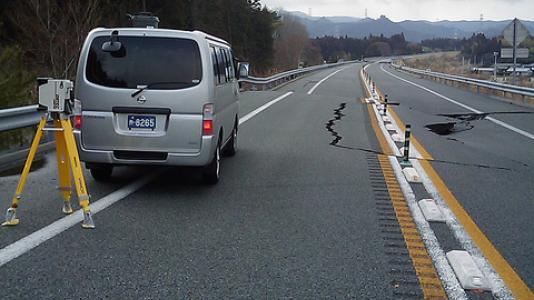
Part of the Radiological Assistance Program (RAP) team, region five, their normal operating ground covers 10 Midwestern states—but this time their expertise was needed abroad. Trained in radiation detection and monitoring, RAP teams are on call twenty-four hours a day to respond to any release of radiological materials in the U.S.
When the reactors at Fukushima Daiichi began to emit radioactive material, the Department of Energy’s national emergency response assets, including several RAP teams, responded to calls from both the U.S. Department of State and the U.S. military. They wanted guidelines on protecting U.S. citizens and military personnel stationed in Japan from radiation hazards; but this raised the enormous task of finding out how much radiation had been dispersed.
In late March, several Argonne members flew to Japan to take over shifts from the initial response team members, who had been working around the clock to take measurements at U.S. military bases, other U.S. interests, and elsewhere in the 50-mile radius around the reactors.
On the ground, small teams set out to comb the earthquake-stricken countryside, radiation detectors in tow. They took hundreds of readings and collected soil samples, mostly between the 20-80 kilometer zone from the plant.
They ran into challenges right away.
“One of the problems we ran into was accessibility,” said Dave Chamberlain, an Argonne chemical engineer with RAP. “When you practice going out to get samples, the classic technique is to divide the area into a grid and take samples say, every 10 meters. But many of the areas we were sampling in Japan were mountainous, forested and damaged by earthquakes, so you can’t stick to the grid plan. We were often limited to roadside sampling.”
“The other difficulty was that we wanted samples from ground that hadn’t been disturbed since the accident,” explained Chamberlain. “If someone had plowed or watered the ground, it changes the dynamics of the distribution—and that time of year is rice planting season in Japan.”
The team measured both the dose rate and the gamma ray spectrum in each area. Gamma ray spectroscopy is a measure of the gamma rays emitted by radioactive particles, and it can be analyzed to determine how much of each different radiological isotope is present. Dose rate is a measure of the dose a human would receive in a particular location over a given amount of time.
The data and samples collected by the teams will be analyzed in labs around the country, providing both information for Japan’s recovery and a more detailed understanding of what happens to radioactive material after it’s released.
“When radiation disperses from a source, you get a plume that travels, and it changes according to wind, moisture and particulates in the air,” explained Argonne RAP scientist Frank Moore. “But once it’s laid on the ground, it moves much less.”
“To get an accurate picture, you have to measure the same location several times over a period,” he said. “Radiological material doesn’t just sit there; it migrates into the environment. It can soak into the soil, or can run off in rivers and streams and collect in low areas. Near roadways, it might collect in the ditches. And it can be taken up into plants.”
The U.S. Department of State coordinated sharing the data with Japanese authorities, Moore said. They also left several detectors behind and trained both U.S. military and Japanese personnel how to use them.
When the RAP team isn’t responding to threats, they provide radiation training to law enforcement—including police, FBI, firefighters and Border Control guards—around the country. Though airports, shipping ports and border crossings are often equipped with radiation detectors, interpreting results from the sensitive instruments can be tricky.
For example, medical patients can sometimes set off radiation monitors in airports; certain procedures use small amounts of radioactive tracers to map the body, and it can take several days for the tracers to decay. But guards with detectors need to be able to tell the difference between medical scan residue and a potentially dangerous source of radiation; the RAP team members provide training to distinguish threats.
Other Argonne RAP team members who assisted in Japan include Steve Bettenhausen and Ray Klann.
The RAP team is one of the DOE’s emergency response assets and is administered by the National Nuclear Security Administration (NNSA).

